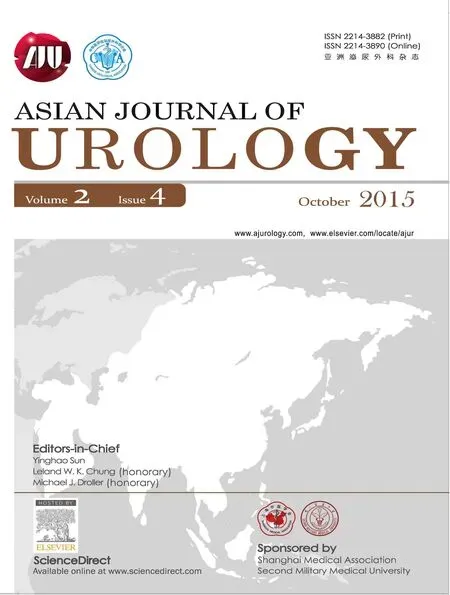Stellate scar sign of renal cell carcinoma
Weibin Hou,Guanghua Liu,Zhigang Ji*
Department of Urology,Peking Union Medical College Hospital,Chinese Academy of Medical Sciences and Peking Union Medical College,Beijing,China
CLINICAL IMAGE
Stellate scar sign of renal cell carcinoma
Weibin Hou,Guanghua Liu,Zhigang Ji*
Department of Urology,Peking Union Medical College Hospital,Chinese Academy of Medical Sciences and Peking Union Medical College,Beijing,China
Stellate scar sign is de fined as the centrally-placed,wellde fined,stellate area of low density on computed tomography(CT)appearance of solid tumors.This kind of radiating enhancement from the center of the tumor,which is also referred as“a spoke-wheel-like enhancement”or central scar sign,usually has been recognized as a specific finding of renal oncocytoma.We describe a patient who developed clear cell renal cell carcinoma(RCC)displaying typical stellate scar sign on CT scans,which was con firmed by gross pathologic appearance.
A 62-year-old Chinese man presented with incidentally detected renal tumor with once ignored gross hematuria half a year ago.Ultrasonography found a 5.6 cm hypoecho mass;CT scans displayed a nearly circular circumscribed mass in the middle of the left kidney,with inhomogeneous enhancement during corticomedullary and nephrographic phases,being an excellent likeness with a spoke wheel (Fig.1).His medical history was not significant except that he had been a heavy smoker for more than 40 years. Laparoscopic nephrectomy of the left kidney surgery was performed for a presumed RCC and the patient recovered uneventfully in postoperative period.The central stellate scar on CT corresponded to fibrous connective tissue on the gross pathological examination;and the color of viable tumor tissue on cross-section is yellow cast of classical clear cell RCC,but not mahogany color of typical renal oncocytoma(Fig.2).Histological examination arrived at the diagnosis of clear cell RCC.
Why a central scar develops in the solid tumor?One explanation which is well recognized is that the tumor mass could outgrow its blood supply as it enlarges,thus leading to concomitant ischemia;eventually,the ischemic tumor could be replaced by a fibrotic scar.Because the blood supply comes from the periphery to the central portion of the mass,the fibrotic scar is more likely to develop in the central region of the mass[1].According to this proposal, stellate scar sign has nothing to do with pathology.Here we present a case with a pathologically confirmed clear cell RCC displaying typical stellate scar sign on CT scans and gross pathological examination.The case strongly supportsthe standpoint that a stellate scar sign on CT scan is not specific for renal oncocytoma and that its existence could not exclude a diagnosis of RCC[2].Extra efforts are needed to achieve the goal of radiological differentiation of oncocytoma from RCC[3].
One possible way to differentiate RCC from renal oncocytoma is renal tumor biopsy(RTB).However,with its potential unfavorable complications and relatively high nondiagnostic biopsy rate[4],RTB is not the standard practice in clinical.What is more,there is a possibility that RCC could co-exist with oncocytoma in rare cases[5],thus the benign biopsy tissue would create a clinical dilemma because it could not rule out a malignant tumor.Thus RTB has not been commonly accepted by either doctors or patients.
Conflicts of interest
The authors declare no conflict of interest.
[1]Lou L,Teng J,Lin X,Zhang H.Ultrasonographic features of renal oncocytoma with histopathologic correlation.J Clin Ultrasound 2014;42:129-33.
[2]Kondo T,Nakazawa H,Sakai F,Kuwata T,Onitsuka S, Hashimoto Y,et al.Spoke-wheel-like enhancement as an important imaging finding of chromophobe cell renal carcinoma:a retrospective analysis on computed tomography and magnetic resonance imaging studies.Int J Urol 2004;11: 817-24.
[3]Woo S,Cho JY,Kim SH,Kim SY.Comparison of segmental enhancement inversion on biphasic MDCT between small renal oncocytomas and chromophobe renal cell carcinomas.AJR Am J Roentgenol 2013;201:598-604.
[4]Leveridge MJ,Finelli A,Kachura JR,Evans A,Chung H,Shiff DA, et al.Outcomes of small renal mass needle core biopsy,nondiagnostic percutaneous biopsy,and the role of repeat biopsy. Eur Urol 2011;60:578-84.
[5]Yousef GM,Ejeckam GC,Best LM,Diamandis EP.Collecting duct carcinoma associated with oncocytoma.Int Braz J Urol 2005; 31:465-9.
Received 28 January 2015;received in revised form 13 July 2015;accepted 28 August 2015
Available online 16 September 2015
*Corresponding author.
E-mail address:jizg1129@163.com(Z.Ji).
Peer review under responsibility of Shanghai Medical Association and SMMU.
http://dx.doi.org/10.1016/j.ajur.2015.09.001
2214-3882/?2015 Editorial Office of Asian Journal of Urology.Production and hosting by Elsevier(Singapore)Pte Ltd.This is an open access article under the CC BY-NC-ND license(http://creativecommons.org/licenses/by-nc-nd/4.0/).
 Asian Journal of Urology2015年4期
Asian Journal of Urology2015年4期
- Asian Journal of Urology的其它文章
- GUIDE FOR AUTHORS
- Ureteral stent technology:Drug-eluting stents and stent coatings
- Laparoscopic ureterolysis with simultaneous ureteroscopy and percutaneous nephroscopy for treating complex ureteral obstruction after failed endoscopic intervention:A technical report
- Implication of ultrasound bladder parameters on treatment response in patients with benign prostatic hyperplasia under medical management
- Prostate chronic inflammation type IV and prostate cancer risk in patients undergoing first biopsy set:Results of a large cohort study
- Does the presence of a percutaneous renal access influence fluoroscopy time during percutaneous nephrolithotomy?
